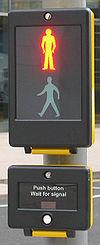
Puffin crossing
Encyclopedia

Pedestrian crossing
A pedestrian crossing or crosswalk is a designated point on a road at which some means are employed to assist pedestrians wishing to cross. They are designed to keep pedestrians together where they can be seen by motorists, and where they can cross most safely across the flow of vehicular traffic...
in use in the United Kingdom
United Kingdom
The United Kingdom of Great Britain and Northern IrelandIn the United Kingdom and Dependencies, other languages have been officially recognised as legitimate autochthonous languages under the European Charter for Regional or Minority Languages...
.
It differs from a pelican crossing
Pelican crossing
A Pelican crossing is a type of pedestrian crossing featuring a pair of poles each with a standard set of traffic lights facing oncoming traffic, a push button and two illuminated, coloured men facing the pedestrian from across the road - a red, stationary man to indicate that it is not safe to...
in that the lights controlling the pedestrians are on the near side of the road, rather than on the opposite side. The system also utilises sensors which detect the presence of pedestrians waiting at the crossing, and as they are crossing the road.
Unlike the older Pelican and Toucan crossing
Toucan crossing
A toucan crossing is a type of pedestrian crossing found in the United Kingdom that also allows bicycles to be ridden across. Since two-can, both pedestrians and cyclists, cross together, the name toucan was chosen....
designs, where the pedestrian signal lights are mounted on the opposite side of the road, the puffin crossing mounts them at the near road side, set diagonally to the road edge. The stated reason for this design was to allow the pedestrian to monitor passing traffic while waiting for the signal to cross. A second stated reason for the design is that having the lights closer to the user would assist visually impaired people who could have difficulty viewing the signal from across the carriageway.
In addition to the positioning of the crossing control lights, some push-button units (the lower box in the picture) are also fitted with a tactile knob under the unit which rotates when the user may cross. This feature is also added to some pelican crossings.
After requesting to cross (by pressing a button) a kerb-side detector monitors the pedestrian's continued presence at the crossing. Should the pedestrian decide to cross prematurely, walk away from the crossing, or wait outside the detection area, the pedestrian's request to cross could be automatically cancelled so traffic is not halted unnecessarily.
An on-crossing detector ensures that the signal for vehicles remains red until the pedestrians have finished crossing (within practical limits). Unlike the pelican crossing, there is no transitional "flashing" phase.
A further difference to the pelican design which this is now replacing, is that when the signal reverts to the normal status, the time delay between successive pedestrian 'green man' indications does not start until the pedestrian push button is pressed. Thus pedestrians will always have a short wait on pressing the cross button. On the pelican system, the delay started as soon as the system finished its cycle so that a pedestrian who pressed the cross button would instantly change the traffic lights if the delay period had expired.
Further reading
- Puffin Good Practice Guide, UK Dept. of Transport, 2006 (http://www.dft.gov.uk/pgr/roads/tss/gpg/puffingoodpracticeguide.pdf)
- Puffin Good Practice Guide Video, UK Dept. of Transport, 2006 (http://www.dft.gov.uk/pgr/roads/tss/gpg/puffingoodpracticeguidevideo.mpg)
- The Installation of Puffin Pedestrian Crossings, UK Dept. of Transport, 2002 (http://www.dft.gov.uk/162259/165240/244921/244924/TAL1-02.pdf)
- Puffin Pedestrian Crossing, UK Dept. of Transport, 2001 (http://www.dft.gov.uk/162259/165240/244921/244924/TAL1-01.pdf)

